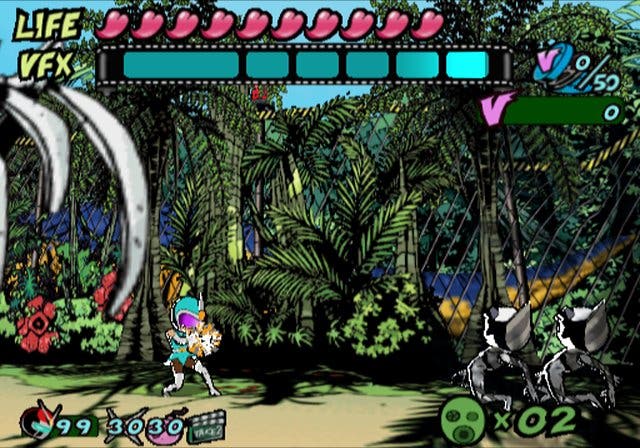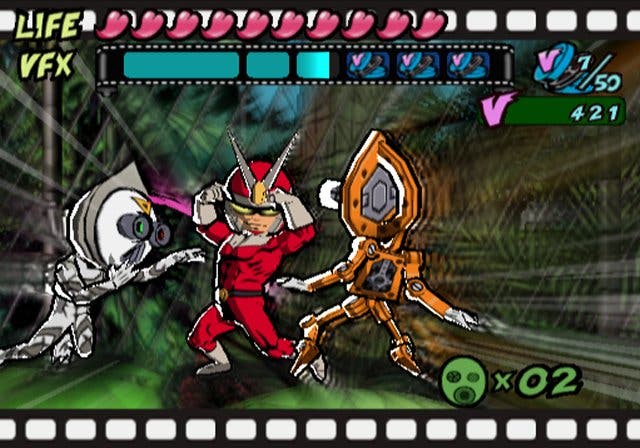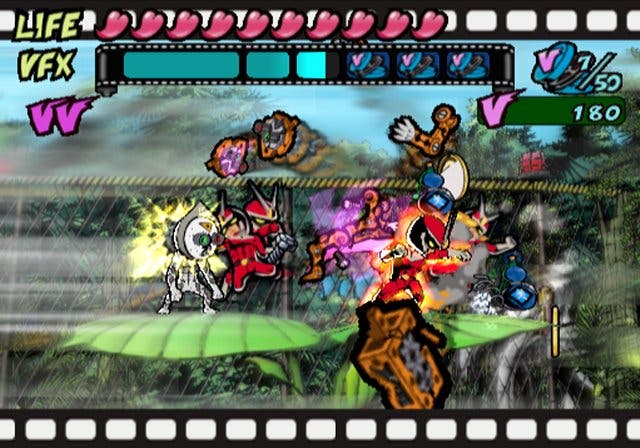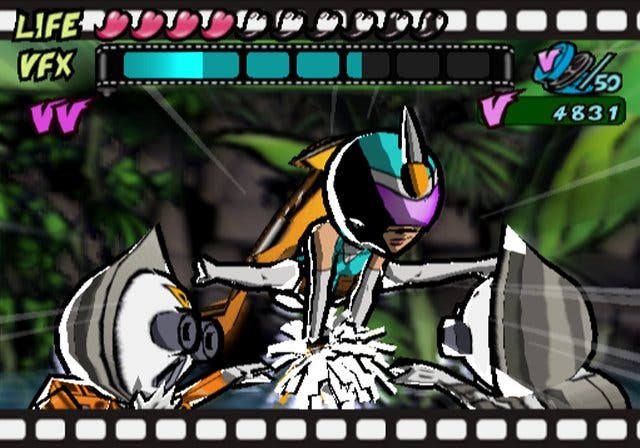Viewtiful Joe 2
Arguably the same cup of Joe.
Order yours now from Simply Games.

"The inevitable sequel" may be more of a truism than a reviewer's joke these days, but, while predicting sequels is becoming easier, what's worrying is that it's also becoming easier to predict which games will not be followed up. Typically it's the games that inspire us most, like Beyond Good & Evil, which get left behind. But Capcom takes a different view, and so we return to Viewtiful Joe, a game that we fully expected to be kissing goodbye to when it came and went nearly two years ago.
But, sadly, while Viewtiful Joe 2 is actually the second Capcom sequel released in Europe in a two-week period to stretch the boundaries of an ageing genre (Resident Evil 4 being the other one, obviously), and a deserved indulgence for Capcom and the folks at its Clover Studio, it doesn't seem to indulge any desire on the designers' part to fundamentally change the game. Pick it up for five minutes and you could swear you're playing the original. In a sense, it is an inevitable sequel - it's certainly not been stripped of what made it good in the first place, but it seems to have lost the original's spirit of adventure.
The biggest changes, perhaps appropriately, feel like they've been in there all along. Partly in that good way - the way that reflects a skilled hand behind the design tools. But mostly in that other way - the sense that they're just not that different to what you already had, and certainly no better. The addition of Joe's girlfriend Silvia as a playable character is welcome, for example, but Joe still has all the best moves - like the all-powerful Slow-Z Red Hot One Hundred, a fan-named technique that eases the passing of most of the game's bosses, drawing on all areas of Joe's skillset to unleash more damage per punch than any other attack in the game.

Silvia's role has actually been downgraded from that of a totally separate character and option for co-operative play to simply being interchangeable with Joe at any point in the game, and that's perhaps reflected in the fact that she looks like she ought to be different, and handles slightly differently, but really isn't that much of a change. She was built to do the same things with a twist, and without the expected total separation this makes for a pretty monotone experience despite the slightly forced need to change between characters every now and then.
She has a gun, for example, which should make it easier to keep high-scoring slow motion combinations alive at distance - very much the heart and soul of playing and enjoying the game - but in practice Joe's ability to use Mach Speed to move through the slow stuff at a reasonable pace and land well-timed blows is just as effective and more gratifying. Silvia lacks the Speed power, and a harsh reviewer might argue that the replacement move she gains simply reflects the spirit of the whole game. Called Replay, it repeats the same move three times in the same instant (don't ask), inflicting three times the damage or landing three simultaneous blows to help solve some tri-fling conundrum.
The story, the combat, the puzzles; the set-up in general is distinctly the same with one exception. The addition of a "Kids" difficulty level alongside the traditional "Adults" - a move that was also made for the PlayStation 2 port of the original game - means that the game is slightly more accessible than before, but don't expect to romp through even that on the first play. VJ remains a game that demands focus and a determination to get the most out of the combat system. That said, it's more inclusive on other fronts - picking the game up from scratch should be no harder, as the same skippable mini-tutorials are still in place in-game - and anybody who skipped on the first game because it was just that bit too difficult will still be able to appreciate this one in isolation.

Time to give newcomers an idea of why Joe is such an acquired taste, then. Both games take Capcom's love of side-on hand-to-hand fighting and marry it to the developer's quirky senses of style and humour, resulting in an imaginative and brilliantly designed combat system of massive depth wrapped up in the happily inconceivable cel- and pastel-shaded adventures of Joe, cinemaphile turned celluloid superhero, and his quest to bring stability back to the worlds of the cheesy films he loves. All that - even the plot stuff - is true of the sequel.
You tackle gorgeously drawn environments inspired by various films (including Jurassic Park and Indiana Jones amongst others; all inspiring rather than being directly referenced) from left to right with elements of three-dimensional depth affected visually in a manner similar to Paper Mario 2's flat-and-it-knows-it approach. So, go round a corner and the world will turn with you and show you its seams. Then, when you come across enemies and they move to attack, a little orange and red skull and crossbones icon appears in relation to Joe or Silvia's chest or knees, giving you warning to dodge in the other direction. Hold up on the analogue stick when you see a knee-high icon and Joe or Silvia will leap above it and stay there without dipping back down until you release the button. When the enemy inevitably swings and misses, they're dizzied and you're given ample time to attack.
A skilled player can get several enemies into this dizzy state at once - and you'll need to be skilled to do it as you get further in and enemies offer more than merely a token resistance, demanding that you slow down time and punch their bullets back at them to stun them, or swinging at you three times at different heights in quick succession before dizzying. But the point is that, once dizzied, enemies become your playthings, and you have lots of toys to whack 'em with.
You can just punch and kick, of course, but you also have modifiers - called VFX powers - that allow you to tie multiple moves together in the same combo and do more damage. Slow motion is the main one. While you hold the button down, all your landed blows will be chained together. Then there's Mach Speed, which allows you to move normally while your enemies are slowed (or alternatively Silvia's Replay, as already discussed), and Zoom, which adds "style", basically closing the camera in on your character, adding another level of visual detail (and speed lines) and upping the damage rate. Excessive combos are fun to craft using these various building blocks, and soon getting those per-section ratings to look respectable becomes just as important to you as making progress.

Graphically you could call it unchanged, but the fact that it looks totally different to everything besides its direct predecessor means we're still far from bored of looking at it. Levels are still drawn on several different levels, with a three-dimensional core of basically-shaped scenery sandwiched nearer and further from the camera by layers of translucent foliage and background art; the characters and enemies are still gorgeously drawn and animated with real verve - it's a game that still loves its identikit enemies and wants them to be especially memorable; and all the effects are magnificent, particularly its use of large quantities of fire and water, and the explosive way robotic enemies splinter and disintegrate under a rain of blows.
But if anything that's what's most representative of Viewtiful Joe 2. Knocking the choice of "Replay" for a new power seems like the obvious thing to do, but overall VJ2 feels like a game that hasn't really changed because it didn't really have to; not a game that's shamelessly rehashing itself. The puzzles, one of the least appreciated but hugely important things about the original, aren't quite as good. Some of them are pure grind, or painfully obvious efforts that shoe-horn whatever you just learnt into puzzle form, and we ought to give special mention to the immensely boring challenge of moving three objects around three rotating rooms using uppercuts and punches, as often battling each object's curious reaction to gravity and tendency to bounce off a wall and then get lodged in the exact same place as actually making progress. But while not up to the same quality as previously, the puzzles still are very good, and very unusual. Like having you uppercut a plug into a socket and then balance your use of Mach speed in a hamster wheel to supply the right level of power to a door.
A bit more subjective than the level design is the quality of the boss encounters. In most cases we weren't as impressed this time around, but it was marginal - so that's praise, not criticism. VJ2's bosses manage to bring all parts of the game together in one encounter - they're brilliantly detailed and imaginative enemies who swap genuinely chucklesome banter before and after the battle, have similarly detailed and imaginative attack patterns to unravel using your various skills, and ultimately aren't that different in spirit or execution to what we had before.

There are some great and recurring characters who you'll fondly remember, some lovely little references and indulgences in their dialogue, and actually fighting them is often just as remarkable as their appearance - if they're not incredibly complex webs to untangle without doing yourself too much injury, then they're just plain unconventional. At one point you fight particular enemies in a mine cart, with the pair of you constantly on the move but your ability to move closer and further from your adversary, leap around and use your various moves retained. Different without really being different. They should put that on the box.
In the end Viewtiful Joe 2 is just that. There are new abilities, new characters, new puzzles, new power-ups to buy in-between levels at the shop, there's a new difficulty level, a new plot involving the plight of seven Rainbow Oscars, new jokes that will make you actually laugh - something a lot of games can only do accidentally - and there's a new "36 Chambers" mode that involves toppling groups of enemies in timed challenges unlocked as you play the game through. And of course there are more unlockables. But it's just not that different, for all the new items on the fact sheet.
Fortunately, then, in staying mostly the same VJ2 remains a prime example of a game where the difference between success and failure is measured in skill rather than forced errors. It's simply unusual to lose because of something the game did. Sure, you can curse it for getting your fingers in a twist with its plethora of functions - most of which have to be deployed simultaneously or in some clever order - but it doesn't kill you deliberately. Everything's sensible - collision detection feels like it's absolute, and when you find yourself reacting too quickly and getting hit because of your timing it's not because it's counterintuitive; it's because the game tricked you.
Well, you needn't let Viewtiful Joe 2 trick you too much. It's a straightforward sequel with a few more bells and whistles than before, and it lowers the bar of entry somewhat compared to the GameCube original. Inevitably there'll be some for whom that isn't enough, but on the whole buying it or not buying it is a very easy call to make. If you enjoyed Viewtiful Joe, you'll enjoy the sequel. If you didn't, you won't. And if you were put off by the difficulty level and can handle the indignity of playing a "Kids" mode then you ought to rent it out and see what you make of it. To our eyes it's still Viewtiful.
Order yours now from Simply Games.







